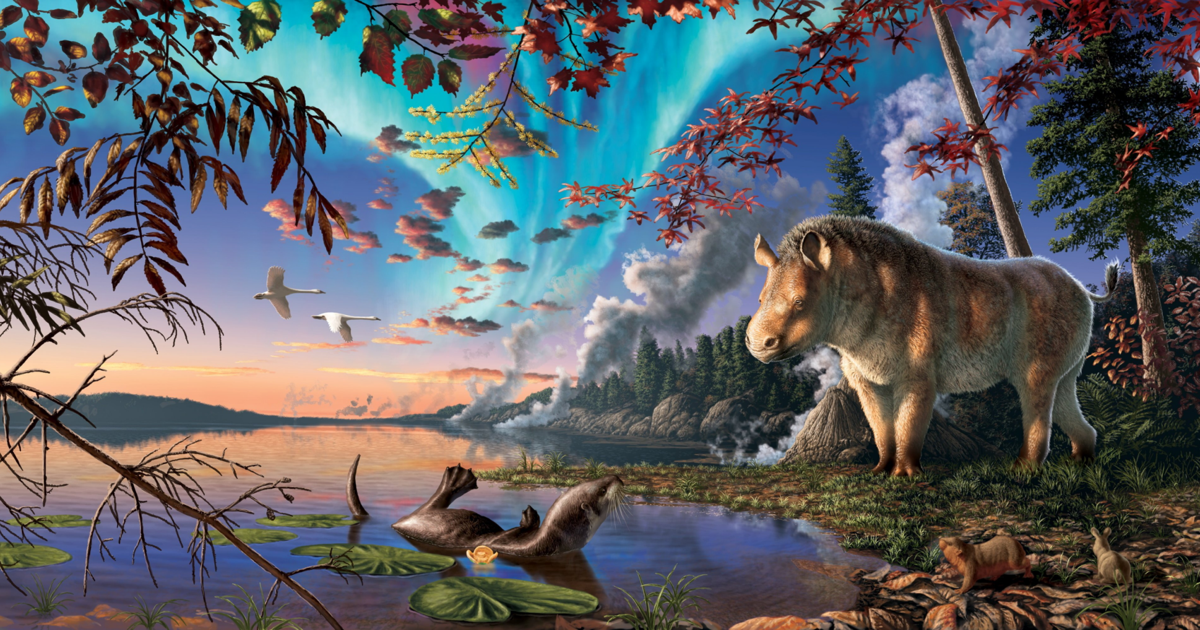(Julius Csotonyi via SWNS)
By Talker
By Stephen Beech
An extinct species of rhino that lived inside the Arctic Circle 23 million years ago has been discovered.
The nearly complete fossilized skeleton was recovered from the fossil-rich lake deposits in Haughton Crater on Devon Island, Nunavut, in the Canadian High Arctic.
It is the most northerly rhinoceros species known.
Rhinos have an evolutionary history that spans over 40 million years, encompassing all continents except South America and Antarctica.
Scientists say the “Arctic rhino” lived about 23 million years ago, during the Early Miocene period and is most closely related to other rhino species that thrived in Europe millions of years earlier.
The discovery of the new species, named Epiatheracerium itjilik, was described in the journal Nature Ecology and Evolution.
Study lead author Dr. Danielle Fraser, head of paleobiology at the Canadian Museum of Nature (CMN), said: “Today there are only five species of rhinos in Africa and Asia, but in the past they were found in Europe and North America, with more than 50 species known from the fossil record.
“The addition of this Arctic species to the rhino family tree now offers new insights to our understanding of their evolutionary history.”
(P.Poirier/CanadianMuseumNature via SWNS)
By Talker
The study also presents an updated family tree for rhinocerotids and provides evidence that the new Arctic species migrated to North America across a “land bridge” that may have been a passage for terrestrial-mammal dispersal millions of years later than suggested by previous evidence.
Dr. Frasers says Epiatheracerium itjilik was “relatively small and slight” – similar in size to the modern Indian rhinoceros, but lacking a horn.
She said the Arctic specimen is thought to be early to mid-adulthood based on moderate wear of the cheek teeth.
The species name “itjilik” means “frosty” or “frost” in Inuktitut.
The research team wanted to honour the rhino’s High Arctic home, so they consulted with Jarloo Kiguktak, an Inuit Elder and former mayor of Grise Fiord, the most northerly Inuit community in Canada.
He has visited the fossil deposits of Haughton Crater and also participated in several expeditions in the High Arctic.
Most of the rhino’s bones were collected at the Haughton Crater site in 1986 by Dr Mary Dawson.
She was Curator Emeritus at the Carnegie Museum of Natural History in Pittsburgh, USA, and a trailblazer in Arctic paleontology.
Dr. Dawson had uncovered the upper and lower teeth, mandibles and parts of the skull, allowing the CMN team to define it as a rhinocerotid and a new species.
Study co-author Marisa Gilbert, senior research assistant with the CMN, said: “What’s remarkable about the Arctic rhino is that the fossil bones are in excellent condition.
“They are three dimensionally preserved and have only been partially replaced by minerals.
“About 75% of the skeleton was discovered, which is incredibly complete for a fossil.”
(P.Poirier/CanadianMuseumNature via SWNS)
By Talker
A series of research expeditions to the Haughton Crater in the late 2000s resulted in the discovery of another new species, the transitional seal ancestor, Puijila darwini.
Additional remains of E. itjilik were found on the later field expeditions led by the CMN.
The team were prospecting the Haughton site as follow-ups to Dawson’s fieldwork.
Dr. Dawson passed away, aged 89, in 2020 and is posthumously cited as the fourth author on the new study.
The team’s analysis offers new insights into how rhinos dispersed over millions of years between North America and Europe, via Greenland, using the North Atlantic Land Bridge.
Previous studies suggested the land bridge may have only have functioned as a dispersal corridor until around 56 million years ago.
But the new analysis with Epiceratherium itjilik and its related species suggests that dispersals occurred from Europe to North America much more recently, potentially as late as the Miocene period.
Dr. Fraser said: “It’s always exciting and informative to describe a new species.
“But there is more that comes from the identification of Epiaceratherium itjilik, as our reconstructions of rhino evolution show that the North Atlantic played a much more important role in their evolution than previously thought.”
She added: “More broadly, this study reinforces that the Arctic continues to offer up new knowledge and discoveries that expand on our understanding of mammal diversification over time.”
The fossil of Epiceratherium itjilik is housed and curated in the fossil collections of the Canadian Museum of Nature in Ottawa.

